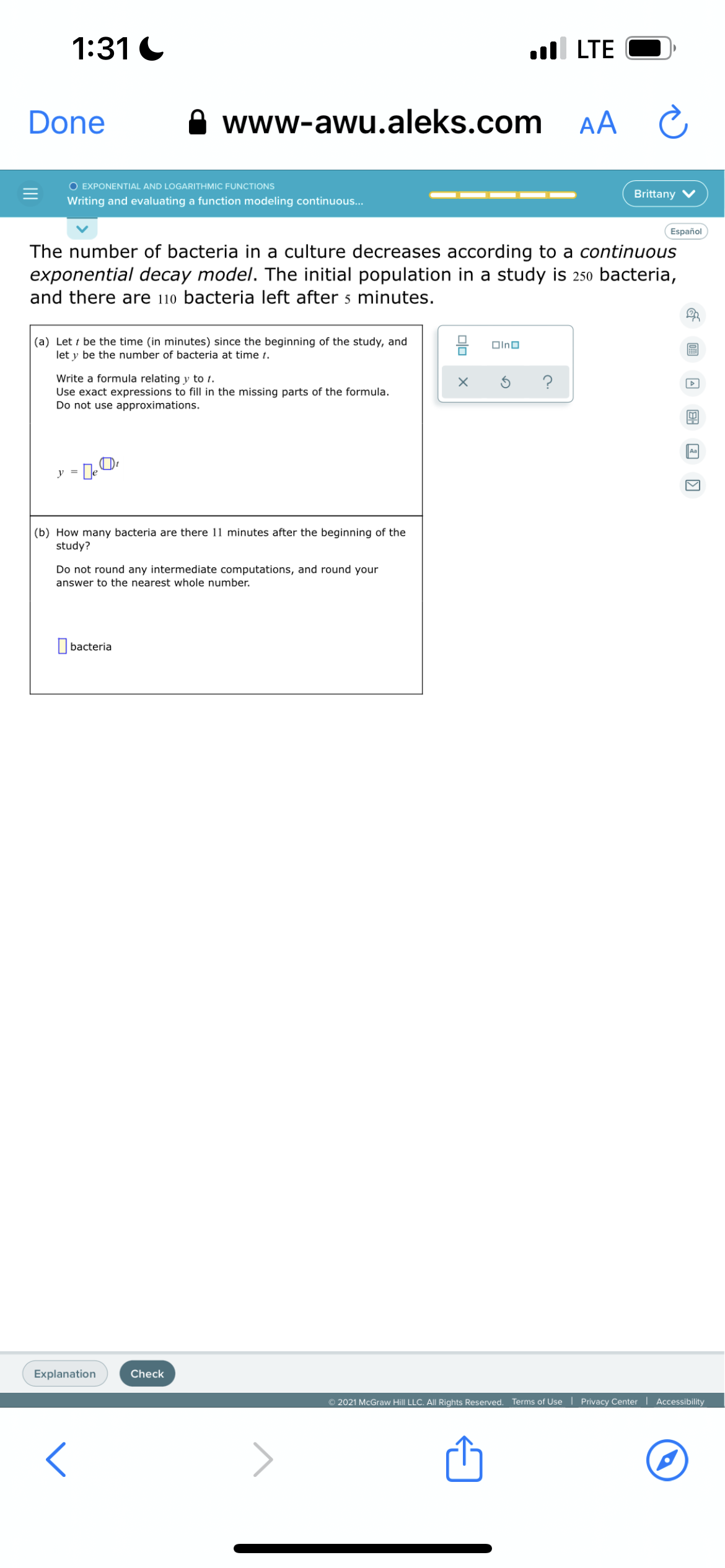O EXPONENTIAL AND LOGARITHMIC FUNCTIONS Brittany V Writing and evaluating a function modeling continuous... Español The number of bacteria in a culture decreases according to a continuous exponential decay model. The initial population in a study is 250 bacteria, and there are 110 bacteria left after 5 minutes. (a) Let t be the time (in minutes) since the beginning of the study, and let y be the number of bacteria at time t. Olno Write a formula relating y to t. Use exact expressions to fill in the missing parts of the formula. Do not use approximations. ? Aa (b) How many bacteria are there 11 minutes after the beginning of the study? Do not round any intermediate computations, and round your answer to the nearest whole number. bacteria II
O EXPONENTIAL AND LOGARITHMIC FUNCTIONS Brittany V Writing and evaluating a function modeling continuous... Español The number of bacteria in a culture decreases according to a continuous exponential decay model. The initial population in a study is 250 bacteria, and there are 110 bacteria left after 5 minutes. (a) Let t be the time (in minutes) since the beginning of the study, and let y be the number of bacteria at time t. Olno Write a formula relating y to t. Use exact expressions to fill in the missing parts of the formula. Do not use approximations. ? Aa (b) How many bacteria are there 11 minutes after the beginning of the study? Do not round any intermediate computations, and round your answer to the nearest whole number. bacteria II
Chapter5: Exponential And Logarithmic Functions
Section5.5: Exponential And Logarithmic Models
Problem 30E: The table shows the mid-year populations (in millions) of five countries in 2015 and the projected...
Related questions
Question

Transcribed Image Text:1:31 C
l LTE
Done
www-awu.aleks.com
AA C
O EXPONENTIAL AND LOGARITHMIC FUNCTIONS
Writing and evaluating a function modeling continuous...
Brittany
Español
The number of bacteria in a culture decreases according to a continuous
exponential decay model. The initial population in a study is 250 bacteria,
and there are 110 bacteria left after 5 minutes.
(a) Let t be the time (in minutes) since the beginning of the study, and
let y be the number of bacteria at time t.
Olno
Write a formula relating y to t.
Use exact expressions to fill in the missing parts of the formula.
Do not use approximations.
Aa
De Di
V =
(b) How many bacteria are there 11 minutes after the beginning of the
study?
Do not round any intermediate computations, and round your
answer to the nearest whole number.
|bacteria
Explanation
Check
© 2021 McGraw Hill LLC. All Rights Reserved. Terms
Use | Privacy Center | Accessibility
Expert Solution
This question has been solved!
Explore an expertly crafted, step-by-step solution for a thorough understanding of key concepts.
Step by step
Solved in 3 steps with 3 images

Recommended textbooks for you


Algebra & Trigonometry with Analytic Geometry
Algebra
ISBN:
9781133382119
Author:
Swokowski
Publisher:
Cengage

Algebra and Trigonometry (MindTap Course List)
Algebra
ISBN:
9781305071742
Author:
James Stewart, Lothar Redlin, Saleem Watson
Publisher:
Cengage Learning


Algebra & Trigonometry with Analytic Geometry
Algebra
ISBN:
9781133382119
Author:
Swokowski
Publisher:
Cengage

Algebra and Trigonometry (MindTap Course List)
Algebra
ISBN:
9781305071742
Author:
James Stewart, Lothar Redlin, Saleem Watson
Publisher:
Cengage Learning

College Algebra
Algebra
ISBN:
9781305115545
Author:
James Stewart, Lothar Redlin, Saleem Watson
Publisher:
Cengage Learning
